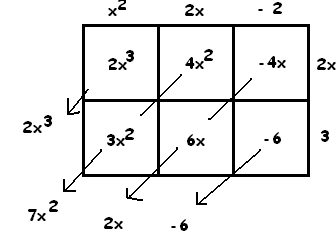The Astounding Power of Area
2.2 Multiplying Polynomials
In our base ten number system, the string of symbols “\(375\)” represents the number \(3\cdot10^{2}+7\cdot10+5\cdot1\). A polynomial is mathematical expression that looks like (or at least can be algebraically manipulated to look like) a number written base \(x\) for some unspecified quantity \(x\). For example, \(3x^{2}+7x+5\) is a polynomial in base \(x\) with integer coefficients (and if we are later told that \(x\) actually represents the number \(10\), then this expression corresponds to the number \(375\), to the number \(31\) if instead we are told \(x\) is \(2\), perhaps). The expression \(\pi w^{3}-5.2w^{2}+\frac{3}{\sqrt{6}}w+100\frac{3}{4}\) is a polynomial in the variable \(w\) with real coefficients.
A natural first appearance of polynomials comes through EXPLODING DOTS here with lesson 1.7 .
Multiplying two polynomials, say \(x^{2} + 2x + 3\) and \(3x+1\), is just as easy, thanks to the area model, as multiplying two integers. (In fact easier, as one never needs to carry with polynomials!)

Notice the convenience of the diagonals: all like powers of \(x\) (or the powers of ten in ordinary arithmetic) match along them.
Of course, the area model is just a representation of Expanding Brackets: select one term from each set of parentheses and sum all possible products. As such, negative terms are permitted as entries in the diagrams.
For example, here is the product of \(x^{2}+2x-2\) and \(2x+3\).

The answer \(2x^{3}+7x^{2}+2x-6\) appears.
Comment: This area model approach for polynomial work is often called the Galley Method.
EXERCISE: Compute the following products via the Galley Method.
a) \(\left(3x^{5}+2x^{4}-5x^{3}+4x^{2}-x+10\right)\left(x^{2}-3x+4\right)\)
b) \(\left(x^{3}-3x+2\right)\left(2x+5\right)\)
c) \(\left(x^{5}-x\right)\left(x^{4}-2x^{2}+1\right)\)
(For nice alignment of the diagonals, redo the second and third examples with zero rows and columns drawn in.)
Resources
Books
Take your understanding to the next level with easy to understand books by James Tanton.
BROWSE BOOKS![]()
Guides & Solutions
Dive deeper into key topics through detailed, easy to follow guides and solution sets.
BROWSE GUIDES![]()
Donations
Consider supporting G'Day Math! with a donation, of any amount.
Your support is so much appreciated and enables the continued creation of great course content. Thanks!
Ready to Help?
Donations can be made via PayPal and major credit cards. A PayPal account is not required. Many thanks!
DONATE![]()


